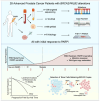Elucidating acquired PARP inhibitor resistance in advanced prostate cancer
- PMID: 39577422
- PMCID: PMC7618010
- DOI: 10.1016/j.ccell.2024.10.015
Elucidating acquired PARP inhibitor resistance in advanced prostate cancer
Abstract
PARP inhibition (PARPi) has anti-tumor activity against castration-resistant prostate cancer (CRPC) with homologous recombination repair (HRR) defects. However, mechanisms underlying PARPi resistance are not fully understood. While acquired mutations restoring BRCA genes are well documented, their clinical relevance, frequency, and mechanism of generation remain unclear. Moreover, how resistance emerges in BRCA2 homozygously deleted (HomDel) CRPC is unknown. Evaluating samples from patients with metastatic CRPC treated in the TOPARP-B trial, we identify reversion mutations in most BRCA2/PALB2-mutated tumors (79%) by end of treatment. Among reversions mediated by frameshift deletions, 60% are flanked by DNA microhomologies, implicating POLQ-mediated repair. The number of reversions and time of their detection associate with radiological progression-free survival and overall survival (p < 0.01). For BRCA2 HomDels, selection for rare subclones without BRCA2-HomDel is observed following PARPi, confirmed by single circulating-tumor-cell genomics, biopsy fluorescence in situ hybridization (FISH), and RNAish. These data support the need for restored HRR function in PARPi resistance.
Keywords: DNA repair; PARP inhibition; cfDNA; genomics; prostate cancer; reversion.
Copyright © 2024 The Authors. Published by Elsevier Inc. All rights reserved.
Conflict of interest statement
Declaration of interests J.d.B. reports personal fees from AstraZeneca, grants and personal fees from Astellas, grants and personal fees from Amgen, grants and personal fees from Bayer, personal fees from BioXcel Therapeutics, personal fees from Crescendo, grants and personal fees from Daiichi, other support from Acai Therapeutics and Dark Blue Therapeutics, personal fees from Genentech/Roche, personal fees from ImCheck Therapeutics, grants from Immunic Therapeutics, grants and personal fees from Janssen, grants and personal fees from Merck Serono, grants and personal fees from Merck Sharp & Dohme, grants and personal fees from MetaCurUm, grant from Myricx, personal fees and other support from Novartis, grant from Nurix Therapeutics, grants and personal fees from Oncternal, grants and personal fees from Orion, grants and other support from Pfizer, grants and personal fees from Sanofi Aventis, and grants and other support from Takeda, outside submitted work; in addition, he has a patent for DNA damage repair inhibitors for treatment of cancer licensed to AstraZeneca and a patent for 17-substituted steroids useful in cancer treatment licensed to Janssen. J.d.B. was named as an inventor, with no financial interest for patent 8,822,438, submitted by Janssen that covers the use of abiraterone acetate with corticosteroids. He has been the CI/PI of many industry-sponsored clinical trials. J.d.B. is a National Institute for Health Research (NIHR) Senior Investigator. P.R. had received fee for advisory board/consulting activities from Janssen, AstraZeneca, Pfizer, Merck, and MSD and received travel support from Ipsen. C.J.L. makes the following disclosures: receives and/or has received research funding from: AstraZeneca, Merck KGaA, Artios, and Neophore; received consultancy, SAB membership, or honoraria payments from: FoRx, Syncona, Sun Pharma, Gerson Lehrman Group, Merck KGaA, Vertex, AstraZeneca, Tango Therapeutics, 3rd Rock, Ono Pharma, Artios, Abingworth, Tesselate, Dark Blue Therapeutics, Pontifax, Astex, Neophore, GlaxoSmithKline, Dawn Bioventures, Blacksmith Medicines, and ForEx; and has stock in: Tango, Ovibio, Hysplex, and Tesselate. C.J.L. is also a named inventor on patents describing the use of DNA repair inhibitors and stands to gain from their development and use as part of the ICR “Rewards to Inventors” scheme and also reports benefits from this scheme associated with patents for PARPi paid into C.J.L.’s personal account and research accounts at the Institute of Cancer Research. A.S. is an employee of the ICR, which has a commercial interest in abiraterone, PARP inhibition in DNA repair defective cancers, and PI3K/AKT pathway inhibitors (no personal income). A.S. has received travel support from Sanofi, Roche-Genentech, and Nurix and speaker honoraria from Astellas Pharma and Merck Sharp & Dohme. He has served as an advisor to DE Shaw Research, CHARM Therapeutics, Ellipses Pharma, and Droia Ventures. A.S. has been the CI/PI of industry-sponsored clinical trials. J.M. has served as advisor for AstraZeneca, Amunix/Sanofi, Daichii-Sankyo, Janssen, MSD, Pfizer, and Roche. He is the PI of research grants to institution funded by AstraZeneca, Pfizer, and Amgen, none of them related to this work.
Figures





Comment in
-
Serial ctDNA to understand PARPi resistance.Nat Rev Urol. 2025 Jan;22(1):3. doi: 10.1038/s41585-024-00984-7. Nat Rev Urol. 2025. PMID: 39653755 No abstract available.
References
-
- Sung H, Ferlay J, Siegel RL, Laversanne M, Soerjomataram I, Jemal A, Bray F. Global Cancer Statistics 2020: GLOBOCAN Estimates of Incidence and Mortality Worldwide for 36 Cancers in 185 Countries. CA Cancer J Clin. 2021;71:209–249. - PubMed
-
- Hussain M, Mateo J, Fizazi K, Saad F, Shore N, Sandhu S, Chi KN, Sartor O, Agarwal N, Olmos D, et al. Survival with Olaparib in Metastatic Castration-Resistant Prostate Cancer. N Engl J Med. 2020;383:2345–2357. - PubMed
-
- de Bono J, Mateo J, Fizazi K, Saad F, Shore N, Sandhu S, Chi KN, Sartor O, Agarwal N, Olmos D, et al. Olaparib for Metastatic Castration-Resistant Prostate Cancer. N Engl J Med. 2020;382:2091–2102. - PubMed
-
- Mateo J, Porta N, Bianchini D, McGovern U, Elliott T, Jones R, Syndikus I, Ralph C, Jain S, Varughese M, et al. Olaparib in patients with metastatic castration-resistant prostate cancer with DNA repair gene aberrations (TOPARP-B): a multicentre, open-label, randomised, phase 2 trial. Lancet Oncol. 2020;21:162–174. doi: 10.1016/S1470-2045(19)30684-9. - DOI - PMC - PubMed
MeSH terms
Substances
Grants and funding
LinkOut - more resources
Full Text Sources
Research Materials
Miscellaneous

